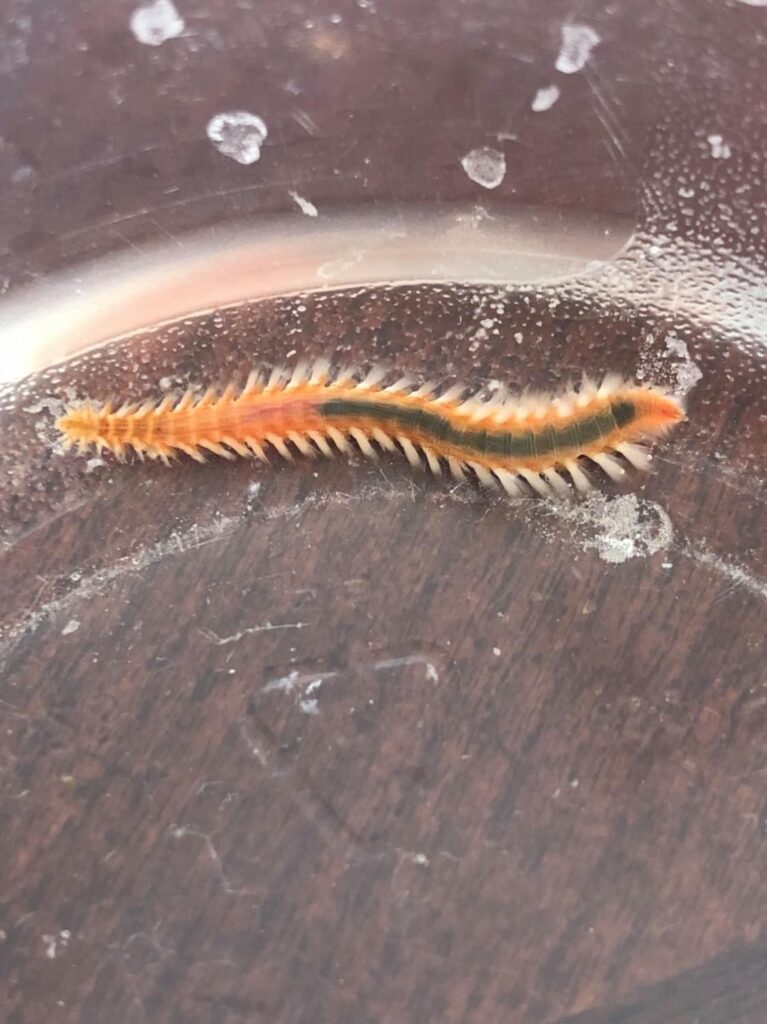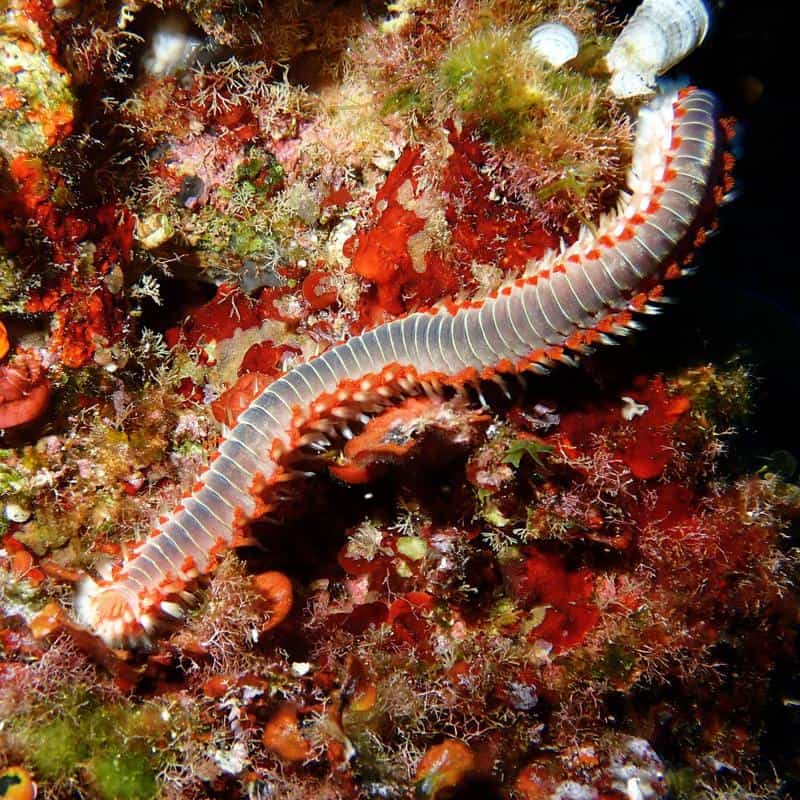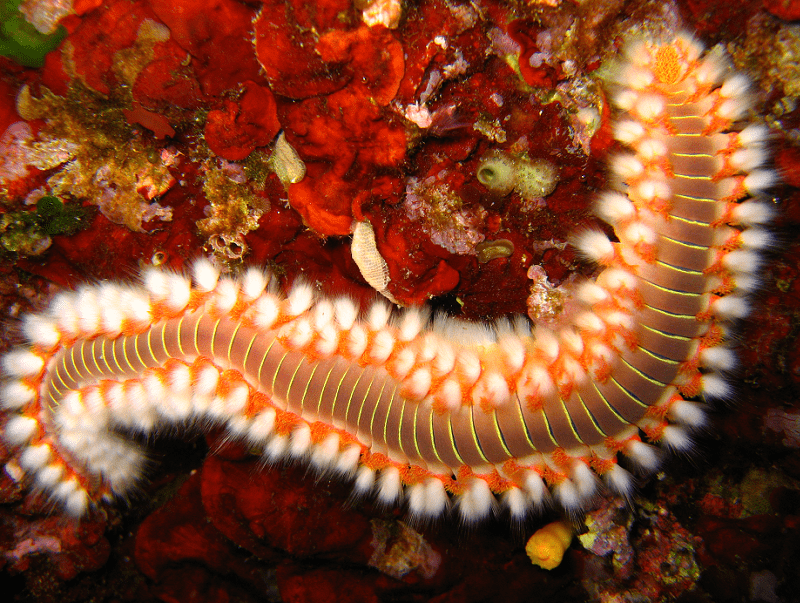Distinguishing between bristle worms and fireworms requires a trained eye for their unique characteristics. Bristle worms exhibit various colors and patterns, while fireworms are easily recognizable due to their vivid red, orange, or yellow coloration, often with iridescent markings. The key difference between bristle worms vs fireworms lies in their bristles, or chaetae. Bristle worms have shorter, thinner, non-venomous bristles, whereas fireworms have more conspicuous, bright white, venomous bristles arranged in dense tufts along their body segments.
Bristle Worms: The Good, The Bad, and The Fuzzy

Bristle worms (Polychaeta) are a class of segmented worms that belong to the phylum Annelida. These marine creatures can be found in various habitats, ranging from the intertidal zones to the deep sea.
Bristle worms play a vital role in the ecosystem, acting as scavengers and helping to break down organic matter.
There are over 10,000 known species of bristle worms, and they can range in size from a few millimeters to several meters in length. The most recognizable feature of these worms is their numerous bristles, or chaetae, which protrude from each body segment.
Bristle worms come in various colors and patterns, and while some are harmless, others possess sharp bristles that can cause irritation if touched.
Fireworms: Beware the Fiery Sting

Fireworms, on the other hand, are a type of bristle worm that belongs to the family Amphinomidae. They are known for their striking appearance and painful sting.
Fireworms are typically red, orange, or yellow, with tufts of white bristles along their bodies. Unlike other bristle worms, fireworms have hollow, venom-filled bristles that can break off and cause intense pain and irritation when they come into contact with human skin.
Fireworms can be found in tropical and subtropical waters, where they are known to feed on coral, algae, and other small invertebrates. They are often seen during the nighttime when they come out of their hiding places to search for food.
bristle worms vs fireworms: how to tell the DIFFERENCE
To accurately identify and distinguish between bristle worms and fireworms, it is essential to consider the following key features:
- Body shape: Both bristle worms and fireworms have elongated, segmented bodies. However, fireworms often appear bulkier due to the dense tufts of bristles protruding from each segment.
- Size: Bristle worms can vary greatly in size, ranging from a few millimeters to several meters long. Fireworms are generally smaller, with most species measuring between 5 and 30 centimeters in length.
- Color and markings: Bristle worms exhibit a diverse range of colors and patterns, including brown, gray, green, and even transparent shades. Fireworms, in contrast, have vivid red, orange, or yellow coloring, often with iridescent blue or green markings on their bodies.
- Bristles (chaetae): While both types of worms have bristles, those of fireworms are more conspicuous due to their bright white color and venomous nature. The bristles of bristle worms are typically shorter, thinner, and less prominent.
- Behavior: Bristle worms are often found burrowing in the sediment or hiding under rocks and other debris. They are more likely to be seen during the day and are generally more sluggish in their movements. Fireworms, on the other hand, are more active during the night and can be seen crawling or swimming in search of food.
- Habitat: Bristle worms inhabit a variety of marine environments, from shallow intertidal zones to deep-sea trenches. Fireworms are predominantly found in tropical and subtropical waters, living in coral reefs, rocky substrates, or seagrass beds.
Are Bristle Worms Good or Bad?
Bristle worms often get a bad reputation due to their appearance and the confusion surrounding their identification. However, the truth is that bristle worms can be both beneficial and harmful, depending on the species and the context.
In many cases, bristle worms are essential components of marine ecosystems, as they help break down organic matter and recycle nutrients. They feed on detritus, dead organisms, and bacteria, which helps maintain a balanced and healthy environment. For this reason, many marine biologists consider bristle worms to be beneficial.
In home aquariums, bristle worms can act as natural janitors, consuming leftover food and waste. This can help maintain water quality and reduce the need for extensive cleaning. However, some bristle worm species may consume coral or other invertebrates, making them unwelcome guests in reef aquariums.
If you encounter a bristle worm in your aquarium, it is essential to identify its species to determine whether it poses a threat to your tank’s inhabitants.
Related: Bristle Worms: Are They Actually Bad For Your Reef Tank?
Difference Between Bristle Worm and Fireworm
The primary difference between bristle worms and fireworms lies in their appearance, bristles, and behavior. While both types of worms belong to the Polychaeta class and share a segmented body structure, fireworms have a more distinct appearance due to their vibrant coloration and prominent white bristles. Bristle worms, in contrast, display a wide range of colors and patterns and have less conspicuous bristles.
Fireworms are a subset of bristle worms, and their bristles are hollow and venomous. When these bristles come into contact with human skin, they can cause painful stings and irritation.
Bristle worms, on the other hand, have non-venomous bristles that are less likely to cause harm.
Additionally, fireworms tend to be more active during the night, while bristle worms are often found burrowing in the sediment or hiding under rocks and debris during the day.
Related: What Eats Bristle Worms? + How I Got Rid of Them In My Tank
FAQ: Bristle Worms
Bristle worms have long been a topic of intrigue and fascination among marine enthusiasts and biologists alike. These often misunderstood creatures can be both beneficial and detrimental, depending on their species and the environment they inhabit. Our FAQ on bristle worms aims to answer common questions and provide a deeper understanding of their biology, behavior, and significance in the marine world.
What is a Bristle Worm?
A bristle worm is a type of marine worm belonging to the Polychaeta class. They are characterized by their elongated, segmented bodies and bristle-like structures called chaetae, which protrude from each segment.
What Do Bristle Worms Do?
Bristle worms play essential roles in marine ecosystems, helping to break down organic matter and recycle nutrients. They feed on detritus, dead organisms, and bacteria, contributing to a balanced and healthy environment.
Where Do Bristle Worms Come From?
Bristle worms inhabit various marine environments, from shallow intertidal zones to deep-sea trenches. They can be found in oceans worldwide, thriving in diverse habitats such as coral reefs, rocky substrates, and sandy bottoms.
Parasite or Pest?
Bristle worms are generally not considered parasites, but some species can be pests in aquariums, especially if they prey on corals or other invertebrates. However, many bristle worms are beneficial, acting as natural janitors by consuming leftover food and waste, helping to maintain water quality.
What Do Bristle Worms Eat?
Bristle worms are primarily detritivores, feeding on dead organic matter, decaying plants, and animals. Some species may also consume small invertebrates or algae. Their diet helps recycle nutrients in marine ecosystems.
Can Bristle Worms Kill Fish?
Bristle worms do not typically pose a threat to fish. They are primarily scavengers and detritivores, focusing on consuming dead organic matter. However, some larger or more predatory species may potentially pose a risk to small, weak, or injured fish. It is essential to identify the specific bristle worm species to determine if it poses any threat to aquarium inhabitants.
Fireworms vs Bristle worms

In conclusion, bristle worms and fireworms are fascinating marine creatures that play crucial roles in their respective ecosystems. While they share similarities in body structure and classification, their distinctive characteristics, such as coloration, bristle morphology, and behavior, set them apart.
Bristle worms, often misunderstood, can be both beneficial and harmful depending on the species and context. Fireworms, with their striking appearance and venomous bristles, demand caution and respect.
By understanding the differences between these two types of worms, marine enthusiasts can appreciate their significance and make informed decisions when encountering them in the wild or in home aquariums.



